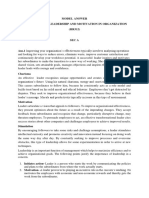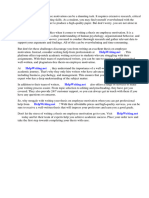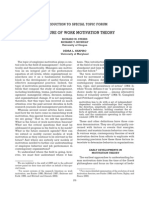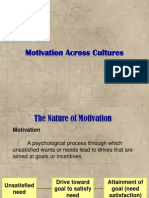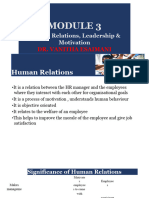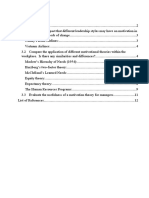UNIT-2
Leadership Motivation and Culture
Leadership motivation refers to the inner drive and passion that leaders possess to influence
and guide others toward achieving organizational goals. It is essential for leaders to be
motivated not only to inspire their teams but also to cultivate a culture where motivation is
nurtured and sustained at all levels of the organization.
Culture refers to the shared values, beliefs, practices, and behaviors within an organization
that influence how employees interact, work together, and approach tasks. A strong
organizational culture can motivate employees by providing a clear sense of purpose,
belonging, and direction. Leadership plays a crucial role in shaping and sustaining this
culture, as leaders set the tone through their actions and decisions.
Motivation Theories for Leadership
Motivation theories provide insights into how leaders can encourage and inspire their
followers to perform at their best. Here are some key motivation theories that can be applied
in leadership:
1. Maslow's Hierarchy of Needs:
o Concept: Maslow’s theory suggests that individuals are motivated by a series
of needs arranged in a hierarchical order: physiological needs, safety needs,
love and belonging needs, esteem needs, and self-actualization.
o Leadership Application: Leaders can motivate their teams by addressing
employees’ needs at different levels. For example, ensuring job security
(safety needs) or providing opportunities for personal growth (self-
actualization) can improve motivation and performance.
2. Herzberg’s Two-Factor Theory:
o Concept: Herzberg proposed that there are two types of factors that affect
motivation:
Hygiene factors: Basic needs like salary, work conditions, and job
security. These factors do not motivate employees but can cause
dissatisfaction if not met.
Motivators: Factors such as achievement, recognition, and
opportunities for growth, which increase job satisfaction and
motivation.
o Leadership Application: Leaders should ensure hygiene factors are addressed
to prevent dissatisfaction, while also providing motivators that encourage
engagement and satisfaction.
3. McClelland’s Theory of Needs:
o Concept: McClelland identified three primary needs that drive motivation:
Need for Achievement: The desire to accomplish difficult tasks and
set high standards.
Need for Affiliation: The desire for harmonious relationships and
social approval.
Need for Power: The desire to influence and control others.
o Leadership Application: Leaders can identify which of these needs are most
important to their employees and tailor their leadership approach to satisfy
those needs.
4. Vroom’s Expectancy Theory:
1
UNIT-2
oConcept: According to Vroom, motivation is influenced by the perceived
likelihood of achieving desired outcomes (expectancy), the value of those
outcomes (valence), and the belief that effort will lead to performance
(instrumentality).
o Leadership Application: Leaders should set clear goals, provide necessary
resources and support, and ensure that rewards are aligned with individual
expectations to enhance motivation.
5. Equity Theory:
o Concept: Equity theory states that employees are motivated by fairness. They
compare their inputs (efforts, skills) and outcomes (rewards, recognition) with
those of others. Perceived inequity can lead to dissatisfaction.
o Leadership Application: Leaders should ensure fairness in distributing
rewards, recognition, and responsibilities to maintain motivation and avoid
demotivation caused by perceived inequity.
Emerging Challenges in Motivating Employees
While motivation theories provide valuable insights, modern organizations face several
challenges in motivating employees, including:
1. Diverse Workforce:
o As workforces become more diverse in terms of age, culture, values, and work
preferences, leaders must tailor their motivational strategies to address these
differences and create an inclusive work environment.
2. Remote and Hybrid Work Models:
o Motivating employees in remote or hybrid settings can be difficult due to the
lack of direct supervision, team interaction, and face-to-face communication.
Leaders need to develop strategies to maintain engagement, foster trust, and
recognize achievements in virtual environments.
3. Work-Life Balance:
o Employees today place a high value on achieving work-life balance. Leaders
must find ways to support flexibility while maintaining productivity. Failing to
respect employees' personal time can lead to burnout and disengagement.
4. Employee Autonomy:
o Many employees today seek more autonomy in their roles and decision-
making. Leaders must find ways to give employees greater control over their
work, which can lead to increased motivation and job satisfaction.
5. Personalized Recognition:
o Generic recognition programs may not be as effective as personalized
approaches. Leaders need to understand individual preferences for recognition
(public vs. private praise, tangible vs. intangible rewards) to maintain
motivation.
6. Mental Health and Well-being:
o Increasingly, leaders are expected to support employees' mental health and
well-being. A lack of support can lead to decreased motivation and
performance. Leaders must cultivate a supportive environment that addresses
stress, burnout, and other mental health challenges.
2
UNIT-2
Motivation, Satisfaction, and Performance
1. Motivation: Motivation is the internal drive to achieve goals. A motivated employee
is more likely to put in discretionary effort, be engaged, and show commitment to
their work.
2. Job Satisfaction: Job satisfaction refers to the level of contentment employees feel
about their work. Satisfied employees are typically more engaged, loyal, and
productive. Motivation and satisfaction are closely linked, but not always
synonymous. An employee can be motivated to perform well without being satisfied
with every aspect of their job.
3. Performance: Performance refers to how well employees carry out their tasks and
responsibilities. Motivation is a key driver of performance, as motivated employees
are more likely to perform at a higher level. However, job satisfaction, skills,
resources, and leadership support also play crucial roles in determining performance.
To effectively motivate employees, leaders must focus on creating an environment that
fosters both motivation and satisfaction, which in turn enhances overall performance. This
requires not only using the right motivation strategies but also ensuring employees have the
necessary tools, resources, and a supportive culture to perform at their best.
Organisational Culture refers to the shared values, beliefs, norms, and practices that
shape the way members of an organization interact with each other and with external
stakeholders. It influences how employees behave, make decisions, and approach their work.
A strong organizational culture helps to establish a sense of identity and alignment within the
organization.
1. Meaning of Organisational Culture:
Organisational culture is the system of shared assumptions, values, and beliefs that governs
how people behave in organizations. It’s an invisible yet powerful force that influences
organizational success, productivity, employee satisfaction, and overall work environment.
2. Definitions of Organisational Culture:
Edgar Schein (1985): “Organisational culture is a pattern of shared basic
assumptions that the group learned as it solved its problems of external adaptation and
internal integration.”
Deal and Kennedy (1982): “Organisational culture is the way things get done around
here.”
Harrison (1972): “The way the organization does things; what they pay attention to,
how they solve problems, what they value and what they pay attention to.”
3. Significance of Organisational Culture:
Organisational culture plays a critical role in influencing a range of organizational processes
and outcomes. Some key areas where it is significant include:
Employee Engagement and Motivation: A positive culture leads to higher employee
satisfaction, motivation, and retention.
3
UNIT-2
Strategic Alignment: A well-defined culture ensures that employees are aligned with
the organization's mission, values, and strategic goals.
Workplace Environment: Culture influences the overall work environment, whether
it’s collaborative, innovative, competitive, etc.
Adaptability and Innovation: Cultures that encourage innovation and flexibility
allow organizations to adapt to changing market conditions.
Brand Image: The internal culture is often reflected in the public image of the
organization and its relationships with customers, suppliers, and other stakeholders.
4. Dimensions of Organisational Culture:
The dimensions of organizational culture can vary depending on how different cultures are
analyzed. Some common frameworks and dimensions include:
Hofstede's Cultural Dimensions:
o Power Distance: The extent to which less powerful members of the
organization accept and expect power distribution.
o Individualism vs. Collectivism: The degree to which people in the
organization value individual achievement over group success.
o Masculinity vs. Femininity: Whether the organization values competition,
achievement, and success (masculine) or cooperation, care for others, and
quality of life (feminine).
o Uncertainty Avoidance: The organization’s tolerance for ambiguity and
uncertainty.
o Long-Term vs. Short-Term Orientation: How much the culture values long-
term planning versus immediate results.
o Indulgence vs. Restraint: The extent to which people in the organization
control their desires and impulses.
The Competing Values Framework (Cameron & Quinn): Categorizes
organizational cultures based on flexibility vs. stability and internal vs. external focus,
leading to four types:
o Clan Culture: Focused on collaboration, trust, and employee well-being.
o Adhocracy Culture: Focused on innovation, risk-taking, and
entrepreneurship.
o Market Culture: Focused on results, competition, and achieving goals.
o Hierarchy Culture: Focused on control, structure, and formal procedures.
5. Managing Organisational Culture:
To manage and nurture organizational culture effectively, organizations can adopt the
following approaches:
Leadership Commitment: Leaders play a vital role in shaping and maintaining
culture. Their actions and values should align with the desired culture.
Clear Vision and Values: Define and communicate the organizational vision,
mission, and core values regularly to employees.
Employee Involvement: Engage employees in the cultural development process by
involving them in decision-making and idea generation.
4
UNIT-2
Recruitment and Selection: Hire individuals who fit well with the organizational
culture and values. Cultural fit is as important as skill fit.
Training and Development: Offer ongoing training that reinforces cultural values
and expectations.
Reward Systems: Reward behaviors that align with cultural values, reinforcing those
actions throughout the organization.
6. Changing Organisational Culture:
Changing organizational culture can be challenging, but it is possible with strategic effort.
Key steps in changing culture include:
Assess the Current Culture: Understand the existing culture by evaluating employee
surveys, interviews, and organizational performance.
Define Desired Culture: Clearly define the desired culture that aligns with the
organizational goals and values.
Leadership Role in Change: Leaders must model the desired behaviors and support
the culture change process.
Communicate Change: Regularly communicate the reasons for change, expected
outcomes, and steps involved.
Training and Education: Provide employees with the necessary training to embrace
the new culture.
Align Systems and Structures: Modify systems, policies, and reward structures to
reflect the new culture.
Monitor and Reinforce: Continuously monitor progress, recognize improvements,
and reinforce cultural changes over time.
Changing organizational culture is a long-term process that requires commitment, patience,
and flexibility, but when done right, it can lead to greater organizational success and
alignment.
Leadership development is a crucial process for individuals and organizations aiming to build
strong, effective leadership. It plays a vital role in shaping leaders who can inspire, guide, and
motivate teams toward achieving organizational goals. Below are key reasons why leadership
development is significant:
1. Improves Decision-Making
Strong leadership enhances the ability to make informed, effective decisions. Leadership
development helps individuals to assess situations, weigh options, and choose the best course
of action, which is essential for organizational success.
2. Fosters Innovation and Change
Effective leaders drive innovation and lead organizational change. By nurturing leadership
skills, organizations can cultivate leaders who embrace change, encourage new ideas, and
help organizations adapt to evolving markets and technologies.
5
UNIT-2
3. Enhances Employee Engagement
Good leaders inspire and motivate employees, leading to higher levels of job satisfaction and
engagement. Leadership development helps managers and executives develop the emotional
intelligence and interpersonal skills needed to create a positive workplace culture.
4. Increases Productivity and Performance
Leadership development programs help leaders understand how to motivate teams, delegate
responsibilities effectively, and optimize workflow. This leads to increased productivity and
improved performance across the organization.
5. Prepares for Succession Planning
A key component of leadership development is preparing the next generation of leaders.
Organizations that invest in leadership development programs ensure they have a pipeline of
capable leaders ready to take on senior roles when current leaders retire or move on.
6. Boosts Organizational Growth and Success
Leaders play a key role in the strategic direction and long-term success of the organization.
Strong leadership supports growth by aligning teams with the company's vision and by
making effective strategic decisions that drive progress.
7. Builds Stronger Relationships
Leadership development also helps in enhancing communication, collaboration, and
relationship-building skills, both within the team and across the organization. These qualities
are essential for maintaining a cohesive, well-functioning workforce.
8. Enhances Problem-Solving and Conflict Resolution
Leaders often face complex challenges and conflicts within teams. Leadership development
teaches individuals how to approach problem-solving, manage conflicts, and build consensus,
which helps maintain a harmonious and productive environment.
9. Promotes Ethical Leadership
Leadership development can emphasize the importance of ethics and integrity in leadership.
By focusing on ethical decision-making, leaders can foster a culture of trust and
accountability, which benefits both the organization and its stakeholders.
10. Aligns Leadership with Organizational Vision
Well-developed leaders understand and communicate the organization's mission and vision
effectively. Leadership development ensures that leaders can align their strategies with the
company's goals, ensuring a unified approach to organizational objectives.
6
UNIT-2
Continuous Learning: Principles of Learning to Develop Effective Leadership
Continuous learning is a critical component of effective leadership development. It involves
the ongoing process of acquiring, applying, and refining knowledge and skills to adapt to
changing circumstances, inspire teams, and achieve organizational goals. For leaders,
continuous learning fosters personal growth, adaptability, and the ability to lead effectively in
complex environments.
Principles of Learning for Leadership Development
1. Self-Awareness
o Leaders must begin by understanding their strengths, weaknesses, values, and
impact on others.
o Tools like 360-degree feedback, self-assessments, and reflective practices can
aid self-awareness.
2. Goal-Oriented Learning
o Set clear, measurable learning objectives aligned with leadership
competencies.
o Focus on short-term and long-term goals, such as improving communication
skills or strategic thinking.
3. Experiential Learning
o Apply knowledge through real-world experiences like job rotations, project
leadership, or stretch assignments.
o Learning by doing enhances retention and builds confidence in decision-
making.
4. Adaptability and Flexibility
o Leaders should embrace change and be open to learning new approaches to
problem-solving.
o Encourage curiosity and experimentation to find innovative solutions.
5. Feedback and Reflection
o Constructive feedback is essential for identifying areas of improvement.
o Regular reflection on experiences and outcomes helps leaders internalize
lessons learned.
6. Collaborative Learning
o Encourage shared learning through teamwork, mentorship, and peer networks.
o Collaborating with others exposes leaders to diverse perspectives and
strategies.
7. Lifelong Learning Mindset
o Leaders should view learning as an ongoing journey, not a one-time event.
o Stay updated on industry trends, emerging technologies, and global dynamics.
8. Integration of Theory and Practice
o Combine theoretical frameworks with practical applications.
o Use leadership models, such as situational leadership or transformational
leadership, in real-life contexts.
9. Personalized Learning Paths
7
UNIT-2
o Tailor learning strategies to individual needs and career aspirations.
o Provide flexibility in learning formats, such as online courses, workshops, or
coaching sessions.
10. Resilience and Growth Orientation
o Cultivate a growth mindset to view challenges as opportunities for
development.
o Build resilience to persist through setbacks and failures while maintaining
focus on learning goals.
Strategies for Applying These Principles
1. Leadership Development Programs
o Enroll in structured programs that focus on key leadership skills like
communication, emotional intelligence, and strategic planning.
2. Mentorship and Coaching
o Work with experienced mentors or coaches to gain insights and receive
personalized guidance.
3. Action Learning Projects
o Engage in projects that address real organizational issues, allowing leaders to
learn while solving problems.
4. Regular Learning Intervals
o Dedicate time for continuous education through reading, attending seminars,
or taking online courses.
5. Feedback Loops
o Create a culture of open feedback within teams to facilitate mutual growth and
learning.
Vision and Goals for Organizations:
1. Significance of Goals for Leaders:
Leaders are responsible for setting the strategic direction of an organization, and the goals
they establish play a pivotal role in defining the organization's future. The significance of
goals for leaders includes:
Clarity of Purpose: Clear goals help leaders and teams understand what the
organization strives to achieve, guiding all actions and decisions.
Motivation: Well-defined goals motivate employees and stakeholders, aligning their
efforts toward a common purpose. They create a sense of accomplishment when
milestones are achieved.
Strategic Focus: Goals help leaders prioritize tasks, ensuring the organization
focuses its resources on critical areas that will drive success.
Measurement of Progress: Goals provide benchmarks to track progress and evaluate
performance, helping leaders make necessary adjustments to strategies.
Long-Term Sustainability: Well-set goals ensure that short-term actions contribute
to the long-term success and sustainability of the organization.
Inspiration and Legacy: Great leaders leave a lasting impact through their vision and
the goals they set, inspiring future generations to continue the work.
8
UNIT-2
2. Charting Vision and Goals of Indian Leaders:
Indian leaders, both historical and contemporary, have demonstrated unique approaches to
vision-setting and goal accomplishment. Below are examples:
Mahatma Gandhi:
o Vision: Achieving independence from British rule through non-violent means.
o Goals: Unity among Indians, empowerment of the marginalized, and building
a self-sufficient nation (e.g., the Salt March, promoting Khadi).
o Gandhi’s vision influenced not only India but inspired global movements for
peace and freedom.
Jawaharlal Nehru:
o Vision: A modern, secular, and democratic India.
o Goals: Industrialization, technological advancement, education reforms, and
poverty eradication.
o His focus on building institutions like IITs (Indian Institutes of Technology)
and establishing public sector industries set the foundation for India’s
development.
Indira Gandhi:
o Vision: A strong and self-reliant India.
o Goals: Nationalization of banks, green revolution for agricultural productivity,
and taking bold stances in international affairs (e.g., leading India to nuclear
power status).
o She was known for her decisive leadership, though her tenure also faced
controversy.
Narendra Modi:
o Vision: Transform India into a global leader by embracing technological and
economic advancements.
o Goals: Digital India, Make in India, Swachh Bharat (Clean India), and
financial inclusion (e.g., Jan Dhan Yojana).
o Modi’s leadership focuses on transforming India into a digital and
manufacturing powerhouse.
3. Charting Vision and Goals of International Leaders:
Globally, influential leaders have also set compelling visions and goals that reshaped their
countries and, in some cases, the world.
Winston Churchill (UK):
o Vision: Defeat Nazi Germany and protect the sovereignty of Britain during
World War II.
o Goals: Mobilize Britain’s war effort, sustain morale during the war, and
strengthen alliances (e.g., with the U.S. and USSR).
o Churchill’s leadership during World War II left a legacy of resilience and
determination.
Nelson Mandela (South Africa):
9
UNIT-2
o Vision: A racially integrated and democratic South Africa.
o Goals: Overthrow apartheid, promote reconciliation, and build a peaceful,
multiracial society.
o His leadership brought about the peaceful transition to democracy in South
Africa, earning global recognition for peace and justice.
Barack Obama (USA):
o Vision: Create a fairer and more inclusive society.
o Goals: Affordable healthcare (Affordable Care Act), job creation, and a
commitment to reducing economic inequality.
o Obama’s presidency is marked by a focus on domestic policy reforms, while
also fostering international diplomacy (e.g., Iran nuclear deal, Paris Climate
Agreement).
Angela Merkel (Germany):
o Vision: A stable, unified European Union and a strong, sustainable German
economy.
o Goals: Leadership in handling the Eurozone crisis, promoting sustainability,
and ensuring Germany’s role as a global economic power.
o Merkel’s steady and pragmatic leadership made her one of the most influential
European leaders of the 21st century.
Comparison of Leadership Vision and Goals: Indian and global leaders share common
themes of creating better societies, enhancing economic prosperity, and fostering
international peace. However, the methods and scope of their visions often differ based on
their cultural, political, and historical contexts.
Historical Context: Indian leaders like Gandhi and Nehru focused on national
liberation and post-colonial development, while international leaders like Churchill
and Mandela emphasized overcoming global challenges like war and racial injustice.
Innovation and Technology: More recent leaders, like Narendra Modi, Barack
Obama, and Angela Merkel, highlight the role of technology, economic integration,
and international diplomacy.
Societal Transformation: Leaders such as Gandhi and Mandela focused on social
justice and human rights, while others like Merkel and Obama worked toward
institutional reforms and sustainability.
10























































